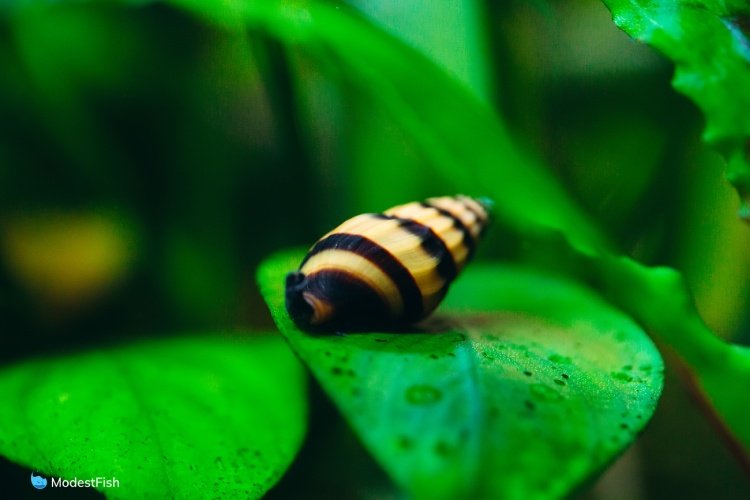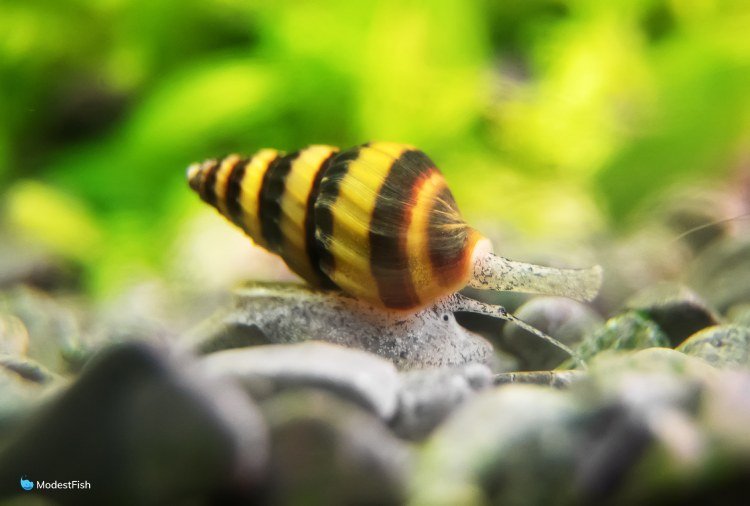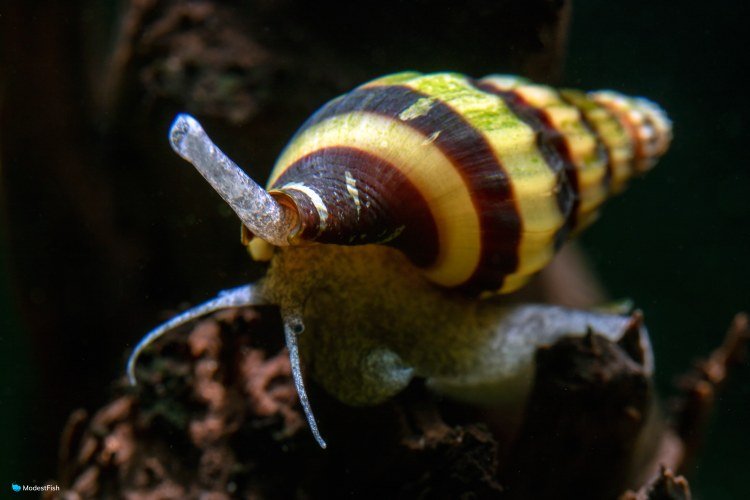[ad_1]
Assassin Snails (Anentome helena) are attractive, interesting, and very useful when in the right aquarium.
In this guide, I’ll help you weigh up if an assassin snails are right for you, what kind of aquarium they require and how to provide them with an environment they’ll thrive in.
Quick Stats
- Care Level: easy
- Min. Tank Size: 30 gallons (113 liters)
- pH: 7.0-8.0
- Temperature: 68°-80°F (20°-27°C)
- Diet: carnivore
- Temperament: peaceful with fish, but will predate invertebrates like snails and shrimp
- Lifespan: 2-3 years
- Size: 0.75-1.25inches (2-3 centimeters)
- Family: Nassariidae
- How many can be kept together: can be kept as a single or in a group
- Scientific Name: Anentome helena
- Common Name: assassin snail, bumblebee snail
Assassin Snail Species Profile

Assassin snails have a really unique appearance.
They have a long spiral shell that is ringed by yellow and dark brown stripes, hence their other common name: bumblebee snail.
They have two short antennae that sprout from either side of their heads, similar to what you see on mystery and nerite snails.
Probably the assassin snail’s most unusual feature is their siphon, a fleshy tube that sticks up at an angle from the top of their head.
Assassin snails spend a lot of their time buried in the substrate. The siphon sticks up out of the substrate and is used to pass water over the snail’s gills inside its shell. The siphon is also used to detect movement on the surface.
This alerts the assassin snails to prey that might be passing by or to any predators that are coming close.
If another snail comes near the siphon, the assassin snails will pop out of the substrate and grab it.
If something large or menacing is detected, the snails can tuck themselves into their shell to stay safe.
When an assassin snail retracts into its shell, you can see that it has an operculum. It’s a hard, calcareous flap that acts like a trapdoor, sealing off the snail’s vulnerable soft parts from danger.
In the Wild
Assassin snails are native to Southeast Asia. They can be found in Maylasia, Thailand, Cambodia, Sumatra and Indonesia.
They’re usually found in rivers, streams and canals that have sandy bottoms.
Assassin snails are ambush predators. They often partially bury themselves in the sand, leaving their siphons near the surface, waiting for something tasty to come along.
They’ll eat worms, shrimp, other snails, pretty much any little critter they can manage to take down.
All snails have an organ known as a radula. It’s kind of like a tongue that’s covered with little toothlike structures that they use to scrape food into their mouths.
Assassin snails use their radulas to scrape at their prey, drawing blood and weakening the animal. The smell of blood will then attract other assassin snails and they will all gang up together to take down larger prey animals.
They can extend their radulas pretty far out from their bodies, it looks almost like a little elephant trunk. They dig through the substrate with the radula looking for snails and detritus worms buried below the surface.
Assassin snails can insert their radula into the shell of other snails in order to bite and even suck them out of their shells.
It’s…uh, well, kinda brutal actually.
But, anyone with a really bad pond snail infestation would probably think it was sweet, sweet revenge for all the plants the pest snails destroyed.
When the radula is unfolded, it extends longer than the snail’s entire body length. It’s pretty crazy.
They will also scavenge from dead fish they find, but they’re too slow to actually hunt fish and kill fish.
In the Aquarium
In the aquarium, assassin snails are a great way to deal with pest snail and detritus worm infestations.
Within a few months, a pair of adult assassin snails can wipe out a pretty bad bladder snail infestation in a 40 gallon (151 liter) tank. I’ve seen this firsthand, it’s pretty amazing.
They might work at a snail’s pace, but slow and steady wins the race…eventually.
Assassin snails are also great at cleaning up leftover fish food that falls down into the substrate.
One of the biggest problems with keeping this species is that they are quite good at their jobs. Assassin snails often end up starving to death because they mow through all the pest snails in a tank and then don’t have anything to eat.
Long term, you will need to provide them with some meaty foods, like bloodworms, California blackworms or shrimp pellets.
How to Set Up a Assassin Snail Tank

Tank Size
Assassin snails need at least a 30 gallon (113 liter) tank and they will do better in a tank with a large footprint instead of a taller tank.
Filtration
This species will require a filter. Aquarium filters don’t just move water around the tank. They’re an essential part of any healthy aquarium.
As urine and feces from fish and invertebrates break down in the tank, they put off deadly byproducts, like ammonia and nitrite.
If these chemicals are allowed to build up in the aquarium, the water will quickly become toxic to any aquatic creatures living in it.
Filters are essential because they detoxify these substances. Specialized beneficial bacteria grow inside of filter media, and transform ammonia and nitrite into nitrate, a substance that can be allowed to build up in between water changes.
This process is known as the Aquarium Nitrogen Cycle and is one of the most essential things to understand about the aquarium hobby.
Pro Tip: For more information about the Nitrogen Cycle, please see our in-depth article, here.
Assassin snails would not be able to survive in a tank without a filter. Don’t worry, they don’t need anything big, fancy or expensive. A simple sponge filter will do just fine, in fact.
For more information about sponge filters, please, see our comparison article, here.
Water Parameters
- Temperature: 68°-80°F (20°-27°C)
- Ammonia/Nitrite: 0
- Nitrate: <30 ppm
- pH: 7.0-6.5
- GH: 6-18 dGH
- KH: 4-10 dKH
Heater
Assassin snails originate from warm, tropical waters and prefer temperatures in the mid to high 70s.
They can survive dips into the upper 60s, but this is less than ideal and they may stop breeding if the temperature stays that low.
You’ll need to add a heater to the tank for these snails to breed and thrive.
Substrate
This species really needs to be kept in a tank with a soft substrate.
Assassin snails spend a lot of time digging around in the substrate, looking for prey.
They also burrow down and partially bury themselves.
They can be kept in tanks with smooth gravel, but it’s better for them to be in a tank with a sandy bottom or aqua soil.
Lighting
This species does not have specific lighting requirements.
Just use whatever kind of lights you want based on your plants and/or viewing preferences.
Plants and Decor
You can keep assassin snails in a planted tank. Since they’re carnivores, they have no interest in tearing up your live plants.
This species will divide their time between climbing on decor and hunting along the substrate.
Sturdy, broadleaved plants, like Amazon swords or anubias, are easier for them to climb on than thin wispy plants like water wisteria.
They’ll gladly scoot along rocks, driftwood or any kind of decor, really.
Assassin Snail Diet
Keeping an assassin snail fed can sometimes be a bit of a challenge.
These guys are often put in the aquarium to keep down populations of pest snails, like bladder or pond snails.
The problem is, they’re very good at their job and often completely wipe out all the available snails.
Once they’ve eaten all the pest snails, they may starve to death.
If you stop seeing pest snails in the tank, do your assassin snails a favor and throw in some food as a reward for a job well done.
You can supplement their diet with meaty foods like:
- Bloodworms
- California blackworms
- Shrimp pellets
- High quality algae wafers (like Omega One Veggie Rounds)
- Flake food
- Brine shrimp
Assassin snails will go after tank mates like ornamental shrimp if they get hungry enough. This is not a myth. There are many videos of assassin snails killing shrimp when they have no other option. Be warned!
Assassin Snail Breeding

Breeding this species is quite simple.
This species is NOT hermaphroditic, meaning they have separate males and females and cannot self-fertilize like other species of snails.
You’ll need to get a group of about six snails to ensure that you get at least one male and one female, and you’ll need to make sure that you provide them with lots of food.
This species breeds more slowly than pest snails, but they do breed readily.
The male will ride on the female’s back for several hours during mating.
After fertilization, the female will lay individual eggs as she glides along a surface. They usually prefer to lay their eggs in small crevices to better hide them.
One cool thing, their eggs have an almost square shape to them. As they get closer to hatching, using a magnifying lens, you can start to see the baby snail within the egg.
It can take 3-8 weeks for the babies to hatch out of the eggs. They usually head down to the substrate, looking for easy prey.
It will take another 2-3 months before the tiny assassin snails grow big enough for a person to easily see them.
It is very easy for assassin snail eggs to hitch a ride into another tank on decor or plants! They can also be highly detrimental to native gastropod species if they are accidentally introduced to local waterways. Please, be cautious!
Assassin Snail Tank Mates
You can mix assassin snails with any sort of peaceful community fish.
Assassin snails will munch on a fish that’s already dead, but they’re far too slow to actually hunt anything that can just swim away.
They also do just fine with most fish that are listed as “semi-aggressive,” like tiger barbs, angelfish and gouramis.
When it comes to ornamental shrimp, I’m a bit on the fence.
As long as they’re well fed, they won’t go after adult shrimp, but if they get really hungry, they absolutely will. And they’ll gladly eat shrimplets.
So, you can do it, but it may cut down on your shrimp breeding, and make absolutely sure your assassin snails have something to snack on.
Here are some tank mates that you should not mix with assassin snails:
- Ornamental snails – even if they’re bigger, the assassin snails will take them down. Some people report that mystery snails and nerites should be safe, and others say their assassins killed these snails in their tanks. I personally wouldn’t risk it.
- Large aggressive fish – large fish will often harass snails, even if they can’t actually eat them. They’ll grab them in their mouths and spit them back out. It seems pretty stressful for the snails. Over time, this abuse can crack a snail’s shell.
- Loaches – most loach species will go after any kind of snail. They’ll pull the snail out of its shell and tear it to bits.
- Pufferfish – puffers love to eat snails, it’s one of their main food sources in the wild. They may not be able to crunch up an adult assassin snail, but they can take chunks out of the snail any time they emerge from their shells, biting off chunks of the siphon, antennae and foot. It’s pretty gruesome.
Is an Assassin Snail Right for You?
This species of snail is attractive, useful and interesting, but they’re not necessarily for everyone.
Keep in mind, a group of assassin snails will breed in your tank, more than likely. So, you’ll be trading a pest snail population for an assassin snail population.
Keep it to only one snail if you want to avoid breeding.
And you might destroy the pest snail population, only to discover that they were eating up an algae bloom, something the assassin snails won’t help you with.
You’ve also got to make sure that they’re getting enough to eat. And you can run the risk that they’ll begin to munch on hapless tank mates if they start to feel peckish.
Plus, it’s easy to accidentally introduce them to other tanks when you transfer decor or plant clippings.
But, as a whole, I think they’re a really cool snail that can help clean up pest outbreaks. They’re often a better choice to keep pest snails in check than a lot of the snail eating fish species in the hobby.
I like having snails as detritivores in my aquariums. They help break down fish waste and clean up food the top dwelling species miss.
I hope you find this article helpful.
I wish you and your fish the very best!
[ad_2]
Source by [author_name]



